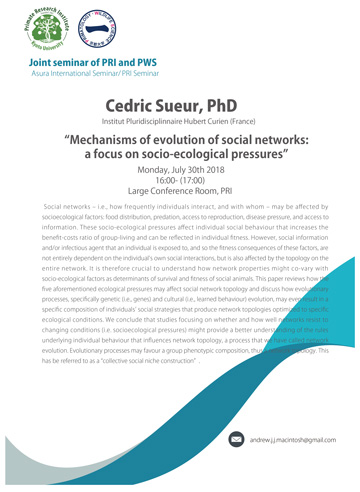Mechanisms of evolution of social networks: a focus on socio-ecological pressures
Date & Time
July 30 (Mon), 2018. 16:00-(17:00)
Location
Large conference room, Primate Research Institute, Inuyama
霊長類研究所 大会議室
Speaker
Cedric Sueur, PhD
Institut Pluridisciplinnaire Hubert Curien, France
Title
Mechanisms of evolution of social networks:
a focus on socio-ecological pressures
Abstract
Social networks ‒ i.e., how frequently individuals interact, a nd with whom ‒ may be affected by
socioecological factors: food distribution, predation, access to reproduction, disease pressure, and access to
information. These socio-ecological pressures affect individual social behaviour that increases the
benefit-costs ratio of group-living and can be reflected in indiv idual fitness. However, social information
and/or infectious agent that an individual is exposed to, and so the fitness consequences of these factors, are
not entirely dependent on the individual's own social interactions, but is also affected by the topology on the
entire network. It is therefore crucial to understand how netwo rk properties might co-vary with
socio-ecological factors as determinants of survival and fitness of social animals. This paper reviews how the
five aforementioned ecological pressures may affect social network topology and discuss how evolutionary
processes, specifically genetic (i.e., genes) and cultural (i.e., learned behaviour) evolution, may even result in a
specific composition of individuals' social strategies that produce network topologies optimized to specific
ecological conditions. We conclude that studies focusing on whe ther and how well networks resist to
changing conditions (i.e. socioecological pressures) might prov ide a better understanding of the rules
underlying individual behaviour that influences network topology, a process that we have called network
evolution. Evolutionary processes may favour a group phenotypic composition, thus a network topology. This
has be referred to as a “collective social niche construction" .
